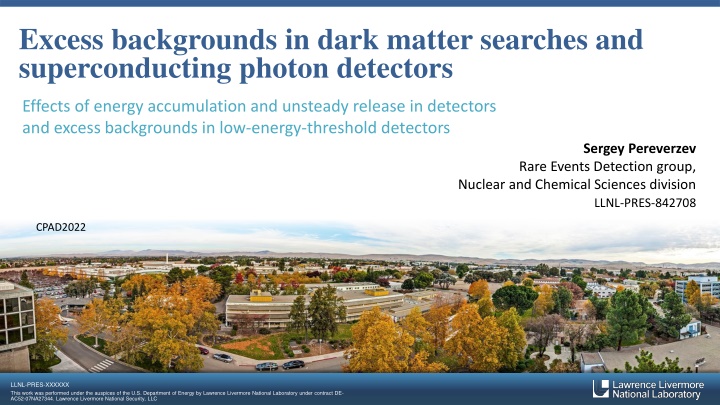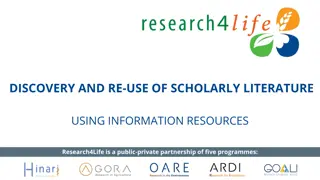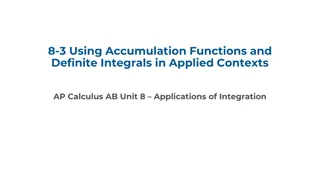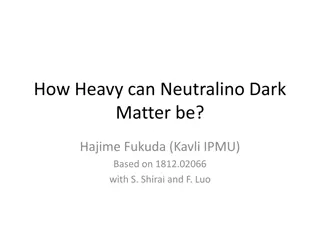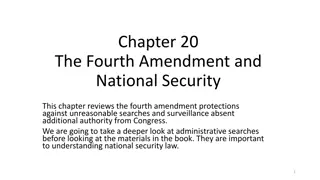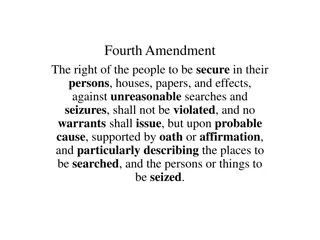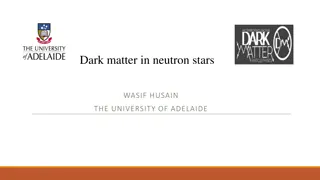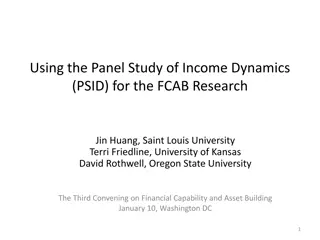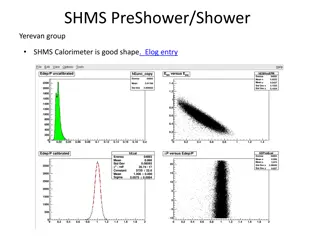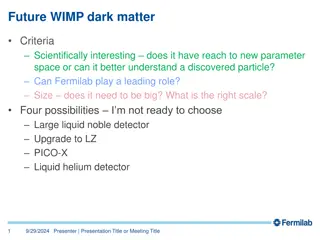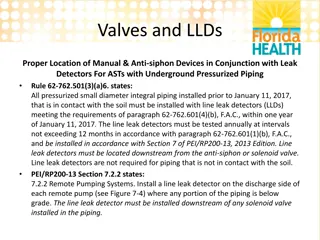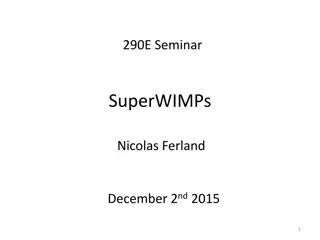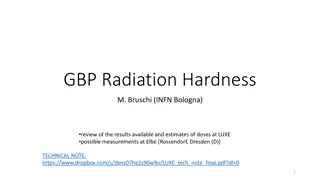Insights into Excess Backgrounds in Dark Matter Searches and Energy Accumulation Effects in Detectors
Explore the impact of excess backgrounds in dark matter searches, energy accumulation, and unsteady releases in detectors. Delve into the implications on low-energy-threshold detectors and the emergence of complex effects in various detector types due to energy accumulation and delayed releases.
Download Presentation

Please find below an Image/Link to download the presentation.
The content on the website is provided AS IS for your information and personal use only. It may not be sold, licensed, or shared on other websites without obtaining consent from the author.If you encounter any issues during the download, it is possible that the publisher has removed the file from their server.
You are allowed to download the files provided on this website for personal or commercial use, subject to the condition that they are used lawfully. All files are the property of their respective owners.
The content on the website is provided AS IS for your information and personal use only. It may not be sold, licensed, or shared on other websites without obtaining consent from the author.
E N D
Presentation Transcript
Excess backgrounds in dark matter searches and superconducting photon detectors Effects of energy accumulation and unsteady release in detectors and excess backgrounds in low-energy-threshold detectors Sergey Pereverzev Rare Events Detection group, Nuclear and Chemical Sciences division LLNL-PRES-842708 CPAD2022 LLNL-PRES-XXXXXX This work was performed under the auspices of the U.S. Department of Energy by Lawrence Livermore National Laboratory under contract DE- AC52-07NA27344. Lawrence Livermore National Security, LLC
Excessive low-energy background (dark matter and coherent neutrino scattering) Variety of detectors and readout techniques Super-SDMS- CDP a c CRESTIII b d a: Xenon 10 experiment, b: Xenon 100, c: Dark Side 50 experiment, 50 kg liquid Ar TPC; d: DAMA-LIBRA experiment,NAI(Tl) scintillator, energy deposition of 1 keV results here in registration 5.5-7.5 photons (Nygren paper0 EXCESS workshop: Descriptions of rising low-energy spectra arXiv:2202.05097 Common features: a sharp rise in the number of low-energy events near material excitations energies Also: long, (history-dependent, glass-like) relaxation processes; background depends on impurities, defects, stress, etc., RESEMBLANCE OF ENERGUY ACCUMULATION AND RELEASES, SELF-ORGANIZED CRITICALITY SCENARIO 2 LLNL-PRES-xxxxxx
Outlook Energy accumulation and delayed releases present in many materials Interactions in between states, defects, configurations bearing excess energy are important: emerging phenomena: avalanche relaxation, correlations in energy releases; potentially can mimic interactions with external particles, produce complex effects in detectors. First-principles models not yet possible; knowledge of phenomenology is incomplete; new effects are predictable by phenomenology analysis Examples: Energy accumulation and releases as luminescence in NaI(Tl), suppression by red light Excess backgrounds in Low-temperature solid-state detectors- relaxation of mechanical stress and delayed relaxation of energy deposited by ionized radiation Superconducting photon and phonon detectors, quantum sensors Noble liquids (separate presentation) Unresolved problems in condensed matter, quantum information Collaboration of HEP and BES (Condensed Matter, Q) physicists) are required 3 LLNL-PRES-xxxxxx
Systems with energy flow Self-Organized Criticality Emerging phenomena in In systems under energy flow Formation of dissipative structures Emerging of order out of chaos Emerging of complexity Per Back, Chao Tang and Kurt Wiesenfeld ( 1991 paper) Self-Organized Criticality Another avenue for complexity 1/f noise explained Ilya Prigogine (left) Noble Price 1977 Prigogine s nonequilibrium thermodynamics ideas are important for understanding of the origin of life and live system functioning, but they are applicable to many complex systems 4 LLNL-PRES-xxxxxx
SOC model (hypothesis) main features Polynomial (not exponential) events spectrum- applicable to particles detectors; probability of a catastrophic event not negligible. Absence of characteristic time or size of avalanche region (a-la phase transition) Noise power spectrum close to 1/f (pink noise)- applicable to superconducting detectors (SQUIDs, TES, etc., qubits) EXAMPLES soft condensed matter - grows of the sand pile, when more material is added to the top and spreads horizontally by avalanches. Low energy particles/ events can cause large events Suppression of large events by reinforcing relaxation at small scale- (put sand pile on vibrating platform ) hardcore condensed matter - crack formation, a motion of quantized vortexes in the superconductor. SOC results are obtained by computer modeling of multi-particles system with known interactions SOC may be or may be not present; no sufficient conditions for the presence 5 LLNL-PRES-xxxxxx
Energy accumulation in material and delayed release after irradiation, stress, electric breakdown, etc. o Thermally stimulated luminescence, electron emission, conductivity Al2O3(I) (personal dosimeters). Up to 13% of radiation energy can be converted to TSL Can be suppressed (erased) by sunlight and by microwave exposure. Light or mechanical stress are known to induce UV luminescence or electron emission in many irradiated materials. Thermoluminescence in alkali metal halides can be suppressed by red /IR light illumination Thermally stimulated conductivity in semiconductors and dielectrics. o Mechanical stress/ deformations lead to delayed photon and exaelectron emissions from metals, semiconductors, dielectrics Studies of deformations defect, dislocation motion in scanning microscopy, electron microscopy o Noble liquids, gases- after-luminescence, appearance of free electrons energy come from long-living excitations in physisorbed solid films on surfaces; slow ions and chemical radicals in bulk Radiation effects in atomic cryogenics solids, E.V. Savchenko et al, NIM B268, 2010 see also M.E. Fajardo and V.A. Apkarian, J.Chem.Phys. 87, 1988 Thermoluminescence in Gamma-Irradiated NaI(Tl) Crystals Nucl. Tracs, Vol.10, pp/107-110, 1985 Energy accumulations is possible in practically all common detector materials Multiple pass ways for excess energy exchange between energy- bearing states/defects/configurations 6 LLNL-PRES-xxxxxx
Energy accumulation and releases in NaI(Tl), suppression of delayed luminescence by red light Felicia Sutanto, Jingke Xu, Adam Bernstein, Sergey Pereverzev Delayed luminescence in NaI(Tl), to be published Random triggering (from external generator) and photon counting in 1 us interval Lasting delayed luminescence days after UV exposure, hours after Co60 exposure, present after muons. Suppression of delayed luminescence by red light exposure after UV exposure, or simultaneous Co60 and red-light exposure. Saint-Gobain claim: particle-like events after UV exposure -required more data analysis (Suppression of background after red light exposure?) Effect of red light exposure was expected ; other environmental factor also can affect delayed luminescence 7 LLNL-PRES-xxxxxx
Delayed luminescence is mostly random flux of single photons, though leakage into particle domain is possible Ba133 data reveals the position of traditional NaI(Tl) pulse in the X1-X2 parameter space (a). UV-induced delayed light emission has the potential to leak into the X1-X2 region of genuine NaI(Tl) pulse (b). flux in 250 us data taking intervals right after UV exposure, at the middle of relaxation and close to equilibrium background . Felicia Sutanto, Jingke Xu, Adam Bernstein, Sergey Pereverzev Delayed luminescence in NaI(Tl), to be published The amounts of energy in immediate light response and in delayed luminescence can be modulated by environmental factors: Temperature, pressure, electric and magnetic fields, AC modulations (Schuman resonances), microwave background, mechanical stress, and vibrations; bunching also can be modulated- so, accurate models of energy in and out fluxes are required. 8 LLNL-PRES-xxxxxx
Building realistic model (uncovering new phenomenology) DAMA-LIBRA experiment Observing yearly oscillation of low energy (1-8 kV ) background for two decades; other experiments do not see this DAMA-LIBRA modulation phase: Muons and residual radioactivity: modulated energy influx Solar neutrinos: insufficient energy for luminescence, can trigger releases Delayed luminescence/background suppression by IR light (suppression of background after red light exposure?) Environmental factors (temperature, pressure ,EMF, microwaves, pressure oscillations, vibrations, etc.) can affect delayed and immediate luminescence No data taken on variation/phase of random delayed luminescence Effects of defects: On delayed luminescence Excitations trapping/clustering around defects- photon bunching Defects production ( also by UV) and accumulation irreproducibility/annealing Photon bunching and leaking through pulse shape filters can be modulated by environmental factors We do not yet uncover all relevant macroscopic phenomenology of the delayed luminescence microscopic processes and models - the next m complex task 9 LLNL-PRES-xxxxxx
Non-interacting Tunneling Two-Level Systems in condensed matter (1972- or Releases of energy by interacting excitations in chemical physics & biology (1977- TLS introduced to describe glasses around 1972 ? Spectrum: Dug Osheroff [1] Tony Leggett[2] P. W. Anderson , B. I. Halperin & c. M. Varma Anomalous low- temperature thermal properties of glasses and spin glasses, Philosophical Magazine, 25:1, 1-9 (1972), W. A. Phillips, Two-level states in glasses , Rep. Prog. Phys. 50, 165723 (1987). Energy accumulation and releases [3] Noble laureates criticizing TLS model Ilya Prigogine Systems with energy flow Self-Organized Criticality- like dynamics Difficulties with microscopic models for TLS [4] Excess background resembles SOC-like dynamics Collabration/ joint program with condensed matter: excess background, glasses, decoherence. 1. 2. The Journal of Physical Chemistry B, 117, pp. 12966-12971, (2013). 3. Per Back, Cho Tang, and Kurt Weisenfeld, Self-organized criticality: An explanation of 1/f noise , Phys. Rev. A 38, 364 (1988). 4. C. Muller, J.H. Cole, J. Lisenfeld, Towards understanding two-level-systems in amorphous solids: Insights from quantum circuits , Reports on Progress in Physics, V.82, 124501 (2019). S. Rogge, D, Natelson, and D. Osherof, Evidence for the Importance of Interactions between Active Defects in Glasses, Phys. Rev. Lett. 76, 3136, (1996). A.J. Leggett, D.C. Vural, Tunneling two-level systems model of the low-temperature properties of glasses: are smoking gun test possible? , 10 LLNL-PRES-xxxxxx
Low-temperature solid-state detectors: phonon burst and quasiparticles production by stress and other energy sources Excess background in solid-state detectors rising with stress o Relaxation/ inelastic deformation in single crystals (semiconductors, dielectrics, metals) goes through dissipative transitions in small volumes: change of crystal structure, formation of twins boundaries, sliding plane, dislocations, dislocation motion, chemical transformation; can be accompanied by light emission and electron emission from the surface. o In materials where irradiation led to energy accumulation (Thermally- Stimulated luminescence, Exaelectron Emission, Conductivity) one can expect burst of phonon, photons, quaseparticles, exaelectrons, etc. (see: Sergey Pereverzev, "Detecting low-energy interactions and the effects of energy accumulation in materials", Phys. Rev. D 105, 063002 (2022). https://arxiv.org/abs/2107.14397 ) Stress Induced Source of Phonon Bursts and Quasiparticle Poisoning. https://doi.org/10.48550/arXiv.2208.02790 We cannot build first principles models yet; we can expect to find new phenomenology, glass-like effects at different energy scales; our empirical models are incomplete. 11 LLNL-PRES-xxxxxx
Multi-mode detection, photon imaging? Multi-mode detection o Simultaneous detection of photons, hot phonon, quasi- particles, magnons, etc.- can help to discriminate particles from relaxation events, or provide directionality, or other information. Detector Detector Phonons break Cooper pairs in absorbers o Photon and phonon detectors have stress, boundaries, trapped ions, excitons, other channels for energy accumulation and releases Substrate o Will we see more burst-like events/spikes as energy sensitivity and time resolution of sensors are improving? SOC- like dynamics in small low-temperature phonon and photon sensors, qubits? 12 LLNL-PRES-xxxxxx
Superconducting Nanowire Single-Photon Detectors Detection of a single 5 m photon with Superconducting Nano-Wire Photon Detector (SNSPD). (a) SEM image of an SNSPD with false color for clarity; (b) (b) Absorption of a photon produces a hotspot in a superconducting nanowire. This event destroys superconductivity across the entire width of the nanowire and can be detected as a voltage pulse -(c) Thermal time constant = ~30 ns; Working temperature = ~250 mK-1.5 K nanowire detectors outperform other superconducting photon detectors and PMTs in response time and quantum efficiency, low dark counts have macroscopic sensor (pixel) areas, require cooling to 250- 300 mK, (1.5 K for Near-IR) ; In development: large arrays, working temperature 1.5- 2 K Li Chen et al., Accounts of Chemical Research, V. 50 pp1400-1409 (2017) Detection of IR luminescence t photon level is demonstrated in this paper 13 LLNL-PRES-xxxxxx
SOC-like dynamics and superconducting detectors & qubits Our hypothesis: no dissipation in nanowire or substrate while waiting for photon, i.e. no energy pumping into material, so SOC-type noise production mechanism is suppressed. Example: CMB and IR photon detectors: <<< AC and DC heating <<< Noise equivalent power energy sensitivity >>> MKIDs TES with SQUID array readout Superconducting nanowire Sensors are a parts of microwave resonant circuits Sensors separated from array of SQUIDs; SQUIDS included in resonators DC current in sensors while waiting for click RSFQ -compatible* Microwave and RF signals (applied and leaking from the environment), changes in electric and magnetic fields, and SOC model an addition or an alternative to Tunneling Two-Level Systems model for noise /decoherence. thermomechanical stress are pumping energy into glass-like sub-systems in materials at low temperatures. Interactions of energy-bearing states (defects, charges, magnetic moments, spins, etc., can lead to SOC-like dynamics in sensors and qubits 14 LLNL-PRES-xxxxxx
Improving SNSPD and studying SOC-like effects in quantum systems Increasing Energy sensitivity: Decrease of temperature and decrease of Tc by: Materials/ impurities to lower Tc Suppression by magnetic field Suppression by electric field in thin films Removing low-lying states (including nuclear spins)* SOC-type effects: Pumping energy with photons below superconducting gap Should change of the dark counts dark states spectroscopy * Ultra low noise materials and devices for cryogenic superconductors and quantum bitts- US patent 10,318,880, S. Pereverzev It is important to check if SOC-like dynamics possible in quantum sensors at low and ultra-low temperatures, i.e. in quantum limit. Is up-conversions possible? Spontaneous qubit transition in excited state for non-equilibrium thermal bath? 15 LLNL-PRES-xxxxxx
Conclusions Discrimination of particles interactions from releases of stored energy in the detector materials became more difficult for small-energy interactions and rare events. We have no yet firs principle theoretical models/predictions for the dynamics of Complex System with energy flow; current empirical models seems incomplete. Similarities in phenomenology in glasses (disordered solids), relaxation of defects in solids, and energy accumulation and release dynamics points on possible new effects; making realistic phenomenological models required experiments to find boundaries of these effects/phenomenology. Checking for SOC-like dynamics in superconducting/quantum devices is important for understanding excess backgrounds in HEP experiments and non-thermal noise and decoherence. More collaboration between HEP and BES is required.These include Inclusivity, diversity, engagement, and workforce training aspects. 16 LLNL-PRES-xxxxxx
Disclaimer This document was prepared as an account of work sponsored by an agency of the United States government. Neither the United States government nor Lawrence Livermore National Security, LLC, nor any of their employees makes any warranty, expressed or implied, or assumes any legal liability or responsibility for the accuracy, completeness, or usefulness of any information, apparatus, product, or process disclosed, or represents that its use would not infringe privately owned rights. Reference herein to any specific commercial product, process, or service by trade name, trademark, manufacturer, or otherwise does not necessarily constitute or imply its endorsement, recommendation, or favoring by the United States government or Lawrence Livermore National Security, LLC. The views and opinions of authors expressed herein do not necessarily state or reflect those of the United States government or Lawrence Livermore National Security, LLC, and shall not be used for advertising or product endorsement purposes.
Possibilities for the universal scenario of energy accumulation and releases Energy accumulation and uneven releases o Different temperatures and energy scales Activation over the barrier for energy release: more traps in play at low temperatures More subsystem in material demonstrate glass-like relaxation properties at low temperatures Different energy sources/ energy pumping mechanisms: o Inelastic deformation/stress/thermomechanical stress Produce defects, chemical transformation, electronic excitations, charges, trapped charges o Ionizing radiation Produce ions, electronic excitations, trapped ions, defects o Not ionizing radiation: optical, IR, microwaves, changes of temperature, electric and magnetic field In semiconductors, magnetics, superconductors, superfluid's: excitons, magnetic ordering, surface charges, quasiparticles, sub-gap excitations, quantized vortexes o Changes of pH, temperature, pressure, electric and magnetic field In biological /chemical systems: chemical changes, molecular conformations, aggregations, etc. conditions Interactions between states and defects bearing excessive energy may lead to SOC-like dynamics or more complex correlations, and mimic interactions with particles. 18 LLNL-PRES-xxxxxx
Glasses/ disordered solids We learn a lot about crystal materials in physics courses, but most substances around us are in a glass-like state Relaxation processes in glasses at temperatures below glass transition became long, non-exponential, history-dependent The time scale for relaxation could be long: from milliseconds to days and years; Many types of relaxation processes: Mechanical deformations (flow) Changing of electric polarization when an electric field is applied, Changing of optical transparency (level burning, when notch spectral transparency is induced by a powerful laser pulse) Changes of Magnetization or magnetic susceptibility; spin glasses magnetic moments (spins) can be positioned in a perfect crystal lattice; not a geometrical disorder, but the presence of multiple energy minima as a function of magnetic moment orientation, frustration History-dependent relaxation indicates that relaxation depends on the internal state of the material; Excessive energy can be present; photon and electron emission after inelastic deformation are examples With cooling, more subsystems in materials can demonstrate glass-like relaxation: defects in crystals, charges accumulate on surfaces and in bulk, magnetic moments and nuclear spins in metals and superconductors, etc. 19 LLNL-PRES-xxxxxx
Superconducting Nanowire Single Photon Detectors (SNSPDs) Invented/ demonstrated Wave Length Working Temp Pixel Size/ array size Quantum efficiency Dark counts Time resolution ~2010 1-10 mm/ 0.3- 1 K 30-100 mm/ > 1000 pixels Internal ~1; 50-70% ~0; ~50 ps Professor Gregory Goltzman, Moscow Development to sub-mm? Hot phonon detection? Low cooling power: cryocooler cryocooler +ADR cryocooler + 3He optimization for focal plane, spectrometer Optimization for wavelength SOC like noise suppressed? No dissipation by readout! Molecular dynamics studies possible Current applications: Space IR astronomy, long-distance communications, lidars, quantum communications, dark matter searches, IR spectroscopy Future development Space microwave astronomy, quantum room temperature computer interface, axions detection, CEvNS detectors, study of material sources of athermal noise & decoherence, IR luminescence spectroscopy of live cells ( IR BIOPHOTONICS) Potentially breakthrough technology; important to bring to LLNL 20 LLNL-PRES-xxxxxx
Energy accumulation and releases in material: a brief history of the problem Tunneling, Entanglement Squeezing In non- equilibrium thermodynamics & quantum biology Phenomenology Experimental studies Physics of complex systems ? No theoretical models yet Physics is experimental science! ? HEP detectors Quantum sensors Condensed Matter Chemical physics Cell biology 2022: Excess Background and glass-like relaxation everywhere? ~2010 Interacting TLS in Quantum devises 1987 W.A. Phillips 1972 P.W. Anderson et al., Non-interacting tunneling two-level systems 1988 Self-Organized Criticality 1977 Prigogine (Noble prize) Complex internal interactions Glasses stored energy energy flow 21 LLNL-PRES-xxxxxx
Excessive low-energy background Nobel Liquids dual-phase detectors, NaI(Tl) scintillator c a Dark matter particle detectors operating underground (low background). A: Xenon 10 experiment, 10 kg liquid Xe TPC; analysis of electroluminescence signal only; red curve illustrates contribution we expect due to energy accumulation effects in materials. B: Xenon 100 experiment, 100 kg liquid Xe TPC, analysis of electroluminescence signal only; the ~20 photoelectrons registered by PMTs in this experiment correspond to 1 electron extracted from the liquid; excessive few-electron noise is present, C: Dark Side 50 experiment, 50 kg liquid Ar TPC; small signals (below ~5 electrons) are excluded from this analysis; authors admit that they do not understand the excessive background in the range of 4 7 electron events; D: DAMA-LIBRA experiment, NAI(Tl) scintillator, energy deposition of 1 keV results here in registration 5.5-7.5 photons by PMTs; figure from David Nygren paper b d Common feature- sharp rise in number of low-energy events (as energies approaching excitations in materials) 22 LLNL-PRES-xxxxxx
Title-only layout. Font size can be reduced for longer titles. Summary box has a full-width bleed. Delete if not needed. 23 LLNL-PRES-xxxxxx
